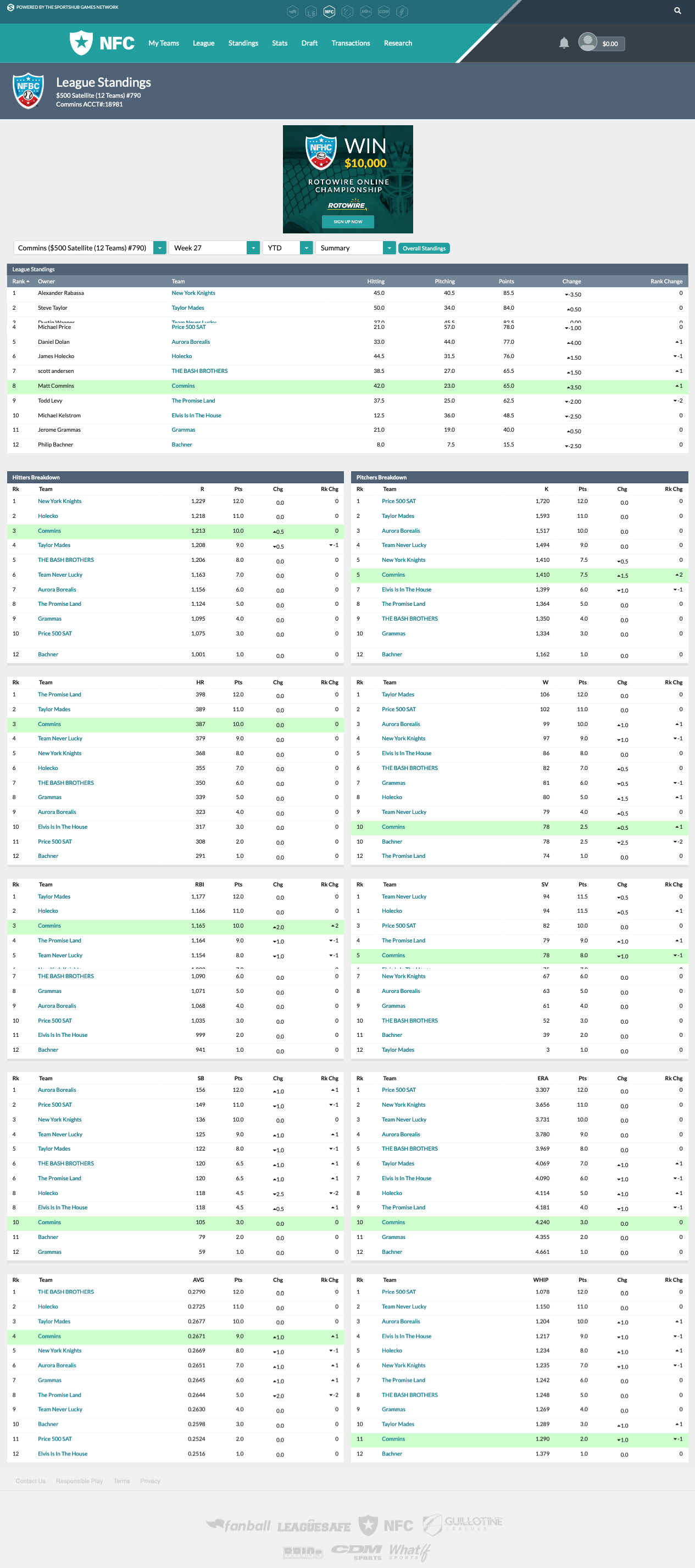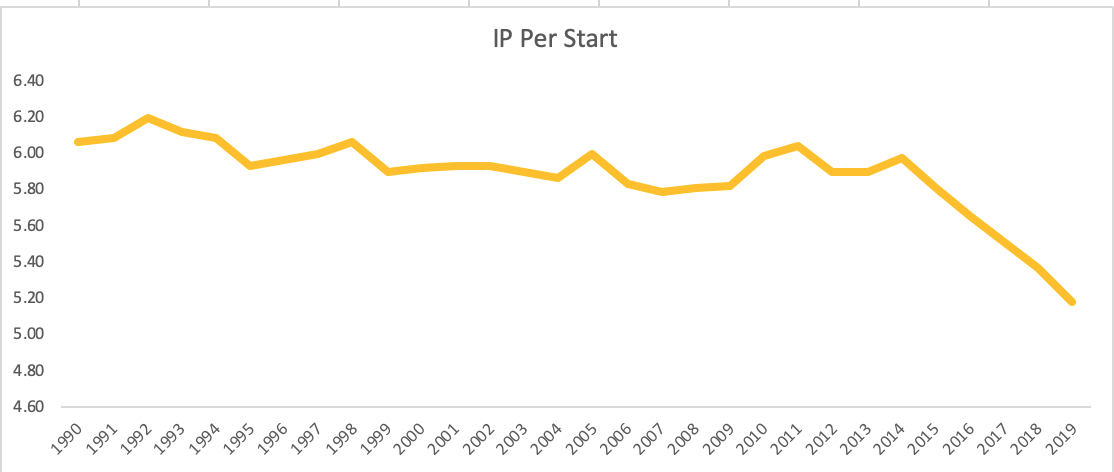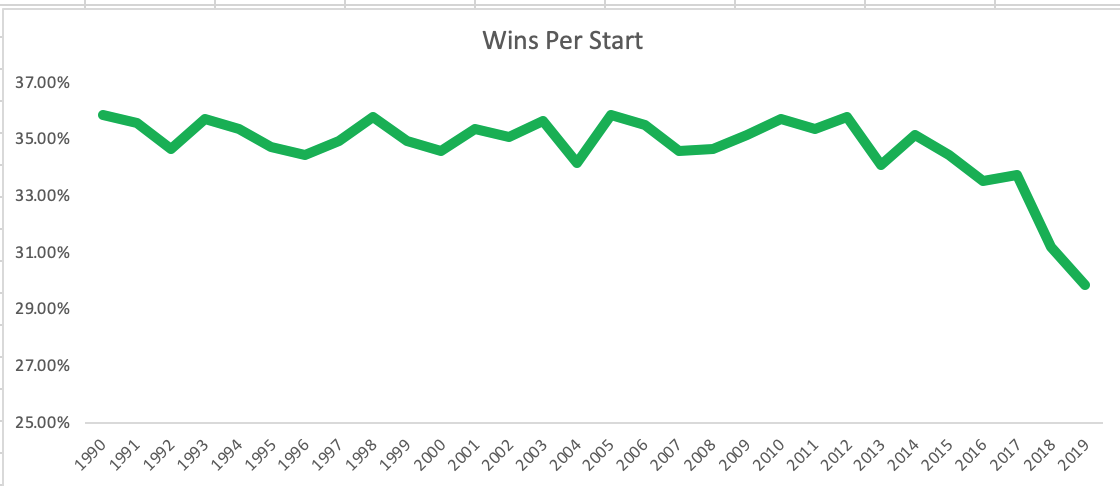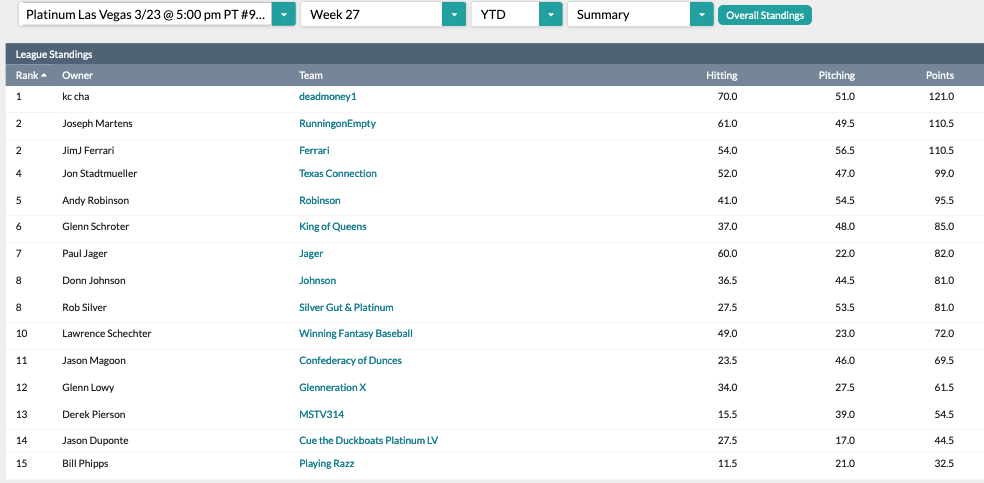This part two of my season recap. (You can see part one here.) For those of who don’t know, every year I write a recap of each of my leagues. This process is masterbatory because the only one who gets any benefit and/or knowledge from this is me.
In this league I didn’t come close to doing as well. To see my recap after the draft and the players I drafted please go here. I will assume you have this knowledge when I provide my analysis.
After the draft I projected the following Hitting Statistics:
Forecast: .267 Avg/ 334 HRs/ 1,198 RBI/ 1,153 Runs/ 164 SBs
Actual: .267 Avg/ 387 HRs/ 1,165 RBI/ 1,213 Runs/ 105 SBs
Pitching Stats:
Forecast: 3.72 ERA/1.21 WHIP/ 1,499 Ks/ 98 W/ 68 Saves
Actual: 4.24 ERA/ 1.29 WHIP/ 1,410 Ks/ 78 W/ 78 Saves
Overall Takeaways From 2019 & 2020
Starters are throwing less innings, getting fewer wins and are striking out more batters. Screenshots below. Now, you’re probably thinking teams are using the opener’s much more now and that is dragging down the numbers. That is true and I need to do more digging on this, but from owning a lot of number three and four starters this year I have noticed very often my guys only five or six innings this year. This is very anecdotal, but these trends suggest it’s even more important to get a top 5-10 starting pitcher in drafts. This season I didn’t draft a top starter; this was intentional as I wanted to find pitching off the waiver wire and I thought I could find “sleepers” later in drafts.
Now, you’re probably thinking teams are using the opener’s much more now and that is dragging down the numbers. That is true and I need to do more digging on this, but from owning a lot of number three and four starters this year I have noticed very often my guys only five or six innings this year. This is very anecdotal, but these trends suggest it’s even more important to get a top 5-10 starting pitcher in drafts. This season I didn’t draft a top starter; this was intentional as I wanted to find pitching off the waiver wire and I thought I could find “sleepers” later in drafts.
Takeaways From My Season
Despite having similar rosters with my other team, the performance in this league was far less. I really needed Trea Turner to steal 50 bases; he missed time after getting hit by a pitch, but even when he came back he didn’t steal that much.If Dave Martinez, the Nationals head coach, comes back I don’t see Turner stealing more than 40 bases next year.
I thought Andrew Benintendi would hit second or leadoff and he would hit 18 home runs, 20 steals with 100 runs, 88 RBI and a .280 batting average. He didn’t come close to that projection at all, but the underlying statistics suggest he got unlucky with the power. His contact rates took a turn for the worse, which may limit his batting average upside. He’ll be 25 next season and I think he’ll be underrated in drafts.
I got unlucky with my closers. David Robertson threw a couple of innings. The Pirates were a bad team, which limited save opportunities. I did pick up Hector Nerris, but I got unlucky with the saves department.
The one positive was I picked up Matt Olson off the waiver wire. What was surprising was no one wanted him. At the time of the waiver wire auction it was reported he was going to play in the Majors in about a week. Despite missing 35 games he finished 12th among first basemen on ESPNs Player Rater.
 The basic reason why my team failed was due to my inability to find pitching off the waiver wire, putting the majority of my stolen base hopes in one player, and getting unlucky.
The basic reason why my team failed was due to my inability to find pitching off the waiver wire, putting the majority of my stolen base hopes in one player, and getting unlucky.
Random Thought
NFBC has a wide range of buy-in leagues from $125 to $15,000. There is one $10,000 and another $15,000 buy-in leagues. Both leagues are 15-team mixed leagues with the same rules. The drafts occurred in Las Vegas. Despite the large buy-in’s there were many people who played in both leagues. Below are screenshots of the standings of both leagues. Do you see anything interesting?
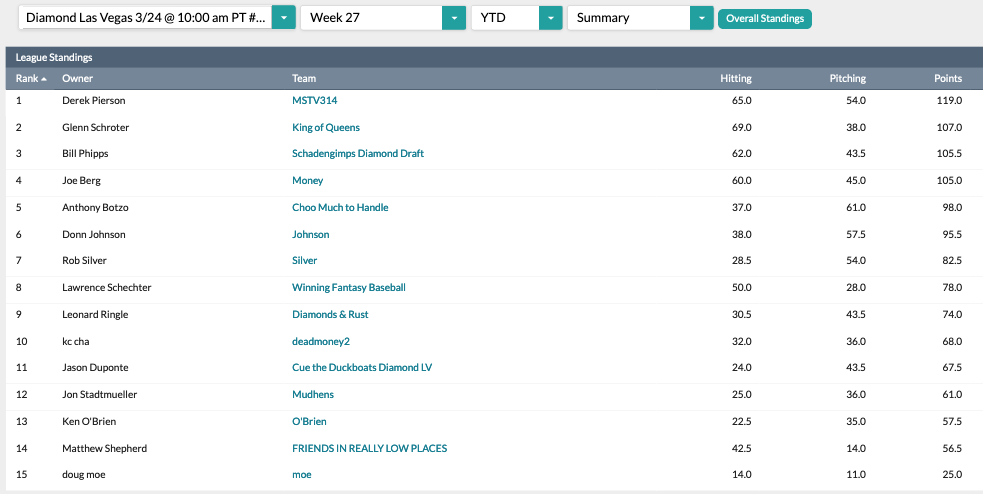 Derek Pierson came in first and 13th while kc char came in first and 10th. In 15-team leagues the performance can vary much more than shallower leagues, but still it’s a pretty wide discrepancy in performance. You can view the drafts of both leagues here. Lastly, the drafts occurred on back-to-back days.
Derek Pierson came in first and 13th while kc char came in first and 10th. In 15-team leagues the performance can vary much more than shallower leagues, but still it’s a pretty wide discrepancy in performance. You can view the drafts of both leagues here. Lastly, the drafts occurred on back-to-back days.
Obviously we’re dealing with a small sample so there is a caveat to all this, but I think there is something to be learned here. You’ll notice the rosters were somewhat similar. One owner had seven players in common (23% of the roster) and the other owner with 11 in common (37%). Most of the duplicate players were in the middle rounds, which suggest the players they drafted, in their owners’ eyes, were undervalued.
When I look at their drafts there were a lot of misses. There were players on both winning rosters that didn’t live up to their draft day value. But the primary reason why they won was they found tremendous value in the middle-to-late rounds (below).
For example, kc char drafted: Nelson Cruz, Yasmani Grandal, Ketel Marte, Jeff McNeil, Jeff Samardzija, Anthony Descalfani, and Lance Lynn.
Another example; Derek drafted: Clayton Kershaw, Hyun-Jin Ryu, Will Smith, Trey Mancini, Kevin Kiermaier, Dakota Hudson, and Sonny Gray.
The biggest takeaway, for me, is to always find value with every pick. You’re going to swing and miss on some picks. It’s okay to swing and miss in the middle rounds and later, but it’s important that your first 1-4 picks work out.
If you find value then you’ll be in a better place to compete. Or in other words, find players who drafted in the middle-to-late rounds that perform like a top 40 pick. That said, and this is the most important takeaway, even when you get more value you never know how much more or less value you’ll get from each player. This is where luck comes into play. For example, literally no one saw a 28/28 season for Wil Myers in 2016 or that Blake Snell would have a Cy Young season in 2018. Anyone who says they knew they were going to perform like that is full of shit. If they truly believed that they wouldn’t have been drafted in round 20.

